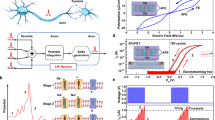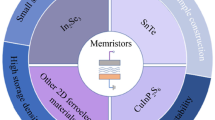Abstract
Recent discovery of ferroelectricity in doped HfO2 has reignited research interest in the ferroelectric field-effect transistor (FeFET) as emerging embedded nonvolatile memory with the potential for neuro-inspired computing. This paper reviews two major aspects for its application in neuro-inspired computing: ferroelectric devices as multilevel synaptic devices and the circuit primitive design with FeFET for in-memory computing. First, the authors survey representative FeFET-based synaptic devices. Then, the authors introduce 2T-1FeFET synaptic cell design that improves its in situ training accuracy to approach software baseline. Then, the authors introduce the FeFET drain–erase scheme for array-level operations, which makes the in situ training feasible for FeFET-based hardware accelerator. Finally, the authors give an outlook on the future 3D-integrated 2T-1FeFET design.









Similar content being viewed by others
References
Y. LeCun, Y. Bengio, and G. Hinton: Deep learning. Nature 521, 436 (2015).
X. Si, J. Chen, Y. Tu, W. Huang, J. Wang, Y. Chiu, W. Wei, S. Wu, X. Sun, R. Liu, S. Yu, R. Liu, C. Hsieh, K. Tang, Q. Li, and M. Chang: A twin-8T SRAM computation-in-memory macro for multiple-bit CNN-based machine learning. In 2019 IEEE International Solid- State Circuits Conference — (ISSCC), San Francisco, CA, USA, 2019, pp. 396–398.
G.W. Burr, R.M. Shelby, S. Sidler, C.d. Nolfo, J. Jang, I. Boybat, R.S. Shenoy, P. Narayanan, K. Virwani, E.U. Giacometti, B.N. Kurdi, and H. Hwang: Experimental demonstration and tolerancing of a large-scale neural network (165 000 synapses) using phase-change memory as the synaptic weight element. IEEE Trans. Electron Devices 62, 3498 (2015).
W. Kim, R.L. Bruce, T. Masuda, G.W. Fraczak, N. Gong, P. Adusumilli, S. Ambrogio, H. Tsai, J. Bruley, J. Han, M. Longstreet, F. Carta, K. Suu, and M. BrightSky: Confined PCM-based analog synaptic devices offering low resistance-drift and 1000 programmable states for deep learning, in 2019 IEEE Symposium on VLSI Technology, Kyoto, Japan, 2019, pp. T66–T67.
W. Wu, H. Wu, B. Gao, P. Yao, X. Zhang, X. Peng, S. Yu, and H. Qian: A methodology to improve linearity of analog RRAM for neuromorphic computing, In 2018 IEEE Symposium on VLSI Technology, Honolulu, HI, 2018, pp. 103–104.
F. Cai, J.M. Correll, S.H. Lee, Y. Lim, V. Bothra, Z. Zhang, M.P. Flynn, and W.D. Lu: A fully integrated reprogrammable memristor–CMOS system for efficient multiply–accumulate operations. Nat. Electron. 2, 290 (2019).
C. Li, D. Belkin, Y. Li, P. Yan, M. Hu, N. Ge, H. Jiang, E. Montgomery, P. Lin, Z. Wang, W. Song, J.P. Strachan, M. Barnell, Q. Wu, R.S. Williams, J.J. Yang, and Q. Xia: Efficient and self-adaptive in-situ learning in multilayer memristor neural networks. Nat. Commun. 9, 2385 (2018).
M. Prezioso, F. Merrikh-Bayat, B.D. Hoskins, G.C. Adam, K.K. Likharev, and D.B. Strukov: Training and operation of an integrated neuromorphic network based on metal-oxide memristors. Nature 521, 61 (2015).
S. Yu: Neuro-inspired computing with emerging nonvolatile memorys. Proc. IEEE 106, 260 (2018).
M. Zhu, K. Ren, and Z. Song: Ovonic threshold switching selectors for three-dimensional stackable phase-change memory. MRS Bull. 44, 715 (2019).
X. Gu, Z. Wan, and S.S. Iyer: Charge-trap transistors for CMOS-only analog memory. IEEE Trans. Electron Devices 66, 4183 (2019).
X. Guo, F.M. Bayat, M. Bavandpour, M. Klachko, M.R. Mahmoodi, M. Prezioso, K.K. Likharev, and D.B. Strukov: Fast, energy-efficient, robust, and reproducible mixed-signal neuromorphic classifier based on embedded NOR flash memory technology. In 2017 IEEE International Electron Devices Meeting (IEDM), San Francisco, CA, 2017, pp. 6.5.1–6.5.4.
Y. Lin, F. Lee, M. Lee, W. Chen, H. Lung, K. Wang, and C. Lu: A novel voltage-accumulation vector-matrix multiplication architecture using resistor-shunted floating gate flash memory device for low-power and high-density neural network applications. In 2018 IEEE International Electron Devices Meeting (IEDM), 2018, San Francisco, CA, 2018, pp. 2.4.1–2.4.4.
H. Lue, W. Chen, H. Chang, K. Wang, and C. Lu: A novel 3D AND-type NVM architecture capable of high-density, low-power in-memory sum-of-product computation for artificial intelligence application. In 2018 IEEE Symposium on VLSI Technology,, Honolulu, HI, 2018, pp. 177–178.
H. Lue, P. Hsu, M. Wei, T. Yeh, P. Du, W. Chen, K. Wang, and C. Lu: Optimal design methods to transform 3D NAND flash into a high-density, high-bandwidth and low-power nonvolatile computing in memory (nvCIM) accelerator for deep-learning neural networks (DNN). In 2019 IEEE International Electron Devices Meeting (IEDM), San Francisco, CA, USA, 2019, pp. 38.1.1–38.1.4
M. Jerry, P. Chen, J. Zhang, P. Sharma, K. Ni, S. Yu, and S. Datta: Ferroelectric FET analog synapse for acceleration of deep neural network training. In 2017 IEEE International Electron Devices Meeting (IEDM), San Francisco, CA, 2017, pp. 6.2.1–6.2.4.
H. Mulaosmanovic, J. Ocker, S. Müller, M. Noack, J. Müller, P. Polakowski, T. Mikolajick, and S. Slesazeck: Novel ferroelectric FET based synapse for neuromorphic systems. In 2017 IEEE Symposium on VLSI Technology, Kyoto, 2017, pp. T176–T177.
S. Oh, T. Kim, M. Kwak, J. Song, J. Woo, S. Jeon, I.K. Yoo, and H. Hwang: HfZrOx-based ferroelectric synapse device With 32 levels of conductance states for neuromorphic applications. IEEE Electron Device Lett. 38, 732 (2017).
M. Seo, M. Kang, S. Jeon, H. Bae, J. Hur, B.C. Jang, S. Yun, S. Cho, W. Kim, M. Kim, K. Hwang, S. Hong, S. Choi, and Y. Choi: First demonstration of a logic-process compatible junctionless ferroelectric FinFET synapse for neuromorphic applications. IEEE Electron Device Lett. 39, 1445 (2018).
M.-K. Kim and J.-S. Lee: Ferroelectric analog synaptic transistors. Nano Lett. 19, 2044 (2019).
M. Halter, L. Bégon-Lours, V. Bragaglia, M. Sousa, B.J. Offrein, S. Abel, M. Luisier, and J. Fompeyrine: Back-end, CMOS-compatible ferroelectric field-effect transistor for synaptic weights. ACS Appl. Mater. Interfaces 12, 17725 (2020).
X. Sun, P. Wang, K. Ni, S. Datta, and S. Yu: Exploiting hybrid precision for training and inference: a2T-1FeFET based analog synaptic weight cell. In 2018 IEEE International Electron Devices Meeting (IEDM), San Francisco, CA, 2018, pp. 3.1.1–3.1.4.
T.S. Böscke, J. Müller, D. Bräuhaus, U. Schröder, and U. Böttger: Ferroelectricity in hafnium oxide thin films. Appl. Phys. Lett. 99, 102903 (2011).
S. Dünkel, M. Trentzsch, R. Richter, P. Moll, C. Fuchs, O. Gehring, M. Majer, S. Wittek, B. Müller, T. Melde, H. Mulaosmanovic, S. Slesazeck, S. Müller, J. Ocker, M. Noack, D. Löhr, P. Polakowski, J. Müller, T. Mikolajick, J. Höntschel, B. Rice, J. Pellerin, and S. Beyer: A FeFET based super-low-power ultra-fast embedded NVM technology for 22 nm FDSOI and beyond. In 2017 IEEE International Electron Devices Meeting (IEDM), San Francisco, CA, 2017, pp. 19.7.1–19.7.4.
M. Trentzsch, S. Flachowsky, R. Richter, J. Paul, B. Reimer, D. Utess, S. Jansen, H. Mulaosmanovic, S. Müller, S. Slesazeck, J. Ocker, M. Noack, J. Müller, P. Polakowski, J. Schreiter, S. Beyer, T. Mikolajick, and B. Rice: A 28 nm HKMG super low power embedded NVM technology based on ferroelectric FETs. In 2016 IEEE International Electron Devices Meeting (IEDM), San Francisco, CA, 2016, pp. 11.5.1–11.5.4.
B. Zeng, M. Liao, Q. Peng, W. Xiao, J. Liao, S. Zheng, and Y. Zhou: 2-Bit/cell operation of Hf0.5Zr0.5O2 based FeFET memory devices for NAND applications. IEEE J. Electron Devices Soc. 7, 551 (2019).
K. Chatterjee, S. Kim, G. Karbasian, A.J. Tan, A.K. Yadav, A.I. Khan, C. Hu and S. Salahuddin: Self-aligned, gate last, FDSOI, ferroelectric gate memory device with 5.5-nm Hf0.8Zr0.2O2, high endurance and breakdown recovery. IEEE Electron Device Lett. 38, 1379 (2017).
P.-Y. Chen, B. Lin, I. Wang, T. Hou, J. Ye, S. Vrudhula, J. Seo, Y. Cao, and S. Yu: Mitigating effects of non-ideal synaptic device characteristics for on-chip learning, In 2015 IEEE/ACM International Conference on Computer-Aided Design (ICCAD), Austin, TX, 2015, pp. 194–199.
X. Sun and S. Yu: Impact of Non-ideal characteristics of resistive synaptic devices on implementing convolutional neural networks. IEEE J. Emerg. Sel. Topics Circuits Syst. 9, 570 (2019).
P.-Y. Chen, X. Peng, and S. Yu: Neurosim: a circuit-level macro model for benchmarking neuro-inspired architectures in online learning. IEEE Trans. Comput. Aided Design Integr. Circuits Syst. 37, 3067 (2018).
S. Wu, G. Li, F. Chen, and L. Shi: Training and Inference with Integers in Deep Neural Networks. In International Conference on Learning Representations, Vancouver, BC, Canada, 2018.
K. Ni, M. Jerry, J.A. Smith, and S. Datta: A circuit compatible accurate compact model for ferroelectric-FETs. In 2018 IEEE Symposium on VLSI Technology, Honolulu, HI, 2018, pp. 131–132.
Y. Luo, P. Wang, X. Peng, X. Sun, and S. Yu: Benchmark of ferroelectric transistor-based hybrid precision synapse for neural network accelerator. IEEE J. Explor. Solid-State Comput. Devices Circuits 5 (2019).
S. Ambrogio, P. Narayanan, H. Tsai, R.M. Shelby, I. Boybat, C. di Nolfo, S. Sidler, M. Giordano, M. Bodini, N.C.P. Farinha, B. Killeen, C. Cheng, Y. Jaoudi, and G.W. Burr: Equivalent-accuracy accelerated neural-network training using analogue memory. Nature 558, 60 (2018).
K. Ni, X. Li, J.A. Smith, M. Jerry, and S. Datta: Write disturb in ferroelectric FETs and Its implication for 1T-FeFET AND memory arrays. IEEE Electron Device Lett. 39, 1656 (2018).
D. Reis, K. Ni, W. Chakraborty, X. Yin, M. Trentzsch, S.D. Dünkel, T. Melde, J. Müller, S. Beyer, S. Datta, M.T. Niemier, and X.S. Hu: Design and analysis of an ultra-dense, low-leakage, and fast FeFET-based random access memory array. IEEE J. Explor. Solid-State Comput. Devices Circuits 5, 103 (2019).
P. Wang, Z. Wang, W. Shim, J. Hur, S. Datta, A.I. Khan, and S. Yu: Drain–erase scheme in ferroelectric field-effect transistor—part I: device characterization. IEEE Trans. Electron Devices 67, 955 (2020).
P. Wang, W. Shim, Z. Wang, J. Hur, S. Datta, A.I. Khan, and S. Yu: Drain-erase scheme in ferroelectric field effect transistor—part II: 3-D-NAND architecture for In-memory computing. IEEE Trans. Electron Devices 67, 962 (2020).
K. Florent, S. Lavizzari, L.D. Piazza, M. Popovici, E. Vecchio, G. Potoms, G. Groeseneken, and J.V. IHoudt: First demonstration of vertically stacked ferroelectric Al doped HfO2 devices for NAND applications. In 2017 Symposium on VLSI Technology, Kyoto, 2017, pp. T158–T159.
K. Ni, J.A. Smith, B. Grisafe, T. Rakshit, B. Obradovic, J.A. Kittl, M. Rodder, and S. Datta: SoC logic compatible multi-Bit FeMFET weight cell for neuromorphic applications. In 2018 IEEE International Electron Devices Meeting (IEDM), San Francisco, CA, 2018, pp. 13.2.1–13.2.4.
Acknowledgments
This work was supported, in part, by ASCENT, one of the SRC/DARPA JUMP centers. The authors thank the collaborators Prof. Suman Datta and Prof. Asif Khan and other group members Xiaoyu Sun, Xiaochen Peng, Yandong Luo, Jae Hur, and Zheng Wang.
Author information
Authors and Affiliations
Corresponding author
Rights and permissions
About this article
Cite this article
Wang, P., Yu, S. Ferroelectric devices and circuits for neuro-inspired computing. MRS Communications 10, 538–548 (2020). https://doi.org/10.1557/mrc.2020.71
Received:
Accepted:
Published:
Issue Date:
DOI: https://doi.org/10.1557/mrc.2020.71




